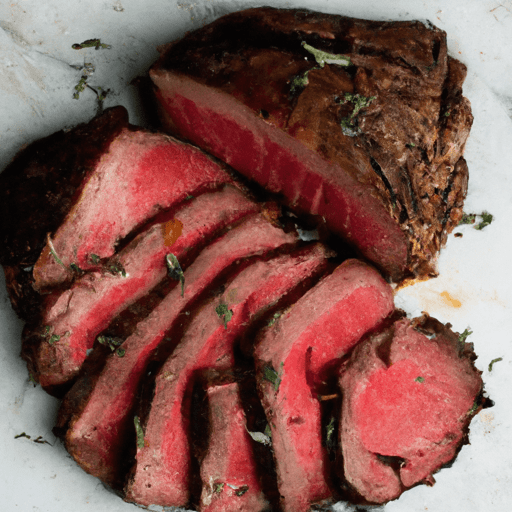Exploring the Exquisite Buffalo Roast: A Delight for the Senses
Are you ready to embark on a culinary adventure that will awaken your taste buds? Look no further than the magnificent buffalo roast! This flavorful and tender cut of meat is a hidden gem in the culinary world, offering a unique taste that is sure to impress even the most discerning palates. In this article, we will delve into everything you need to know about buffalo roast – from its tantalizing taste and common uses in cooking, to its noteworthy nutritional value and interesting history. Let’s get started!
Unveiling the Taste Sensation
When it comes to taste, buffalo roast delivers an unforgettable experience. This lean meat boasts a robust and earthy flavor that is distinctively different from other red meats. Imagine a perfect harmony of richness and tenderness, with a slightly sweet and nutty undertone. The unique taste profile of buffalo roast makes it a delightful choice for those seeking a new and exciting culinary adventure.
Versatile Uses in the Kitchen
Buffalo roast offers endless possibilities in the kitchen. Its rich flavor and tender texture make it an ideal candidate for roasting, braising, grilling, or even slow cooking. The meat’s inherent juiciness allows it to absorb flavors beautifully, making it an excellent canvas for experimentation.
You can prepare a succulent buffalo roast by seasoning it with your favorite spices, herbs, and marinades. Whether you prefer a classic rosemary and garlic rub or a bolder blend of smoky paprika and chipotle, the buffalo roast will graciously absorb those flavors, elevating your dish to new heights. Serve it as the centerpiece of a holiday feast, or slice it thin for tantalizing sandwiches. The versatility of buffalo roast knows no bounds!
A Nutritional Powerhouse
In addition to its exceptional taste, buffalo roast brings notable nutritional benefits to the table. As a lean meat, it is lower in fat and calories compared to other red meats, making it an excellent choice for health-conscious individuals. Buffalo roast is also high in protein, which is essential for building and repairing body tissues. Furthermore, it contains essential vitamins and minerals like iron, zinc, and vitamin B12, which contribute to overall wellbeing. Incorporating buffalo roast into your diet can be a delicious and nutritious way to fuel your body.
A Closer Look at History and Fun Facts
Did you know that buffaloes have roamed the American plains for thousands of years? The indigenous people of North America have revered this magnificent animal for its sustenance and spiritual significance. Historically, buffalo meat played a vital role in Native American cuisine, providing nourishment and sustenance for countless tribes.
With the decline of wild buffalo populations, efforts have been made to conserve and protect these majestic creatures. Thanks to sustainable farming practices, buffalo meat has made a remarkable comeback in recent years and gained popularity among discerning food enthusiasts.
Final Thoughts
The buffalo roast is truly a hidden culinary treasure waiting to be discovered. Its tantalizing taste, versatile uses, and impressive nutritional profile make it a standout choice for any home cook or professional chef. Whether you are looking to impress your dinner guests or simply treat yourself to a delightful meal, the buffalo roast delivers on all fronts. So why not give it a try? Unleash your culinary creativity and savor the remarkable flavor of buffalo roast today!
Remember, whenever you choose to enjoy buffalo roast, savor each bite and appreciate the rich history and flavors that this remarkable meat brings to your plate. Happy cooking!
Note: Always ensure that buffalo meat is sourced from reputable suppliers and farms that prioritize sustainable and ethical practices.
Buffalo Roast
Origin: Buffalo roasts, also known as bison roasts, come from the American bison (scientifically named Bison bison). Native to North America, bison have been an integral part of the Great Plains ecosystem for thousands of years. They were hunted by indigenous peoples for meat, hides, and bones. Today, they are commercially raised for their meat, which provides a lean and flavorful alternative to beef.
Common Uses: Buffalo roast is typically used as a main dish in meals and is often prepared by roasting or braising. It can be seasoned with various herbs and spices to enhance its natural flavors. Buffalo roast is commonly sliced and served with vegetables, gravy, or other accompaniments. Due to its low fat content, it is important to cook it carefully to prevent it from drying out.
Nutritional Benefits: Buffalo meat is known for its nutritional value. It is leaner than beef and provides high-quality protein, essential amino acids, and various vitamins and minerals, including iron and zinc. Compared to beef, it generally contains less total fat, saturated fat, and cholesterol. Buffalo meat is also lower in calories, which makes it appealing for those following a low-fat or low-calorie diet.
Unique Properties and Historical Significance: Buffalo meat has been a staple of Indigenous peoples’ diet for centuries. It played a significant role in their culture, providing sustenance and materials for clothing, shelter, and tools. Explorers and settlers in North America also relied on buffalo meat as a source of food during their westward expansion.
From a culinary perspective, buffalo roast stands out due to its distinct flavor. It has been described as slightly sweeter and slightly gamier than beef. The meat is known for its tenderness and can be cooked to different degrees of doneness, depending on personal preference.
In recent years, there has been a growing interest in consuming bison meat due to its perceived benefits for human health and its potential positive environmental impact compared to conventional livestock production. Buffalo ranching and the availability of buffalo roasts have increased as a result.




Use the share button below if you liked it.
It makes me smile, when I see it.